
COROS has just announced (or rather, the second announcement) of the COROS Dura cycling GPS computer. This computer aims to take their existing watch software, and port it into a GPS bike computer format. Which, as you’ll see, is pretty much what they’ve done. The unit’s standout feature is the higher claimed battery life, with theoretical ‘forever power’ in the right sun conditions via its large solar panel.
I’ve had the COROS Dura for a bit under a month now, which normally would be enough time to put together an in-depth review – especially the many rides I’ve put on it. But at this stage, the unit simply isn’t ready. COROS won’t have a more stable firmware until tomorrow (June 18th, a day after this announcement), and even then, it sounds like many of the issues I’ve raised will take weeks or longer to sort out. Which isn’t saying COROS won’t be able to fix them. I’ve actually got a fair bit of trust in how fast COROS can issue updates and take in feedback, just as they do on the watch side. However, I’d caution that even with all of the fixes in place, there’s still some pretty substantial gaps here to the competition. Inversely, there’s also a couple of compelling features the competition doesn’t have. Though, I think there’s one thing we can all agree on: The price is very interesting.
Point being, this *IS NOT* a review. That’ll come at some point down the road, likely in early July, or whenever they end up start shipping units (now slated for July 15th). With that, let’s dive into it.
The Tech Specs:
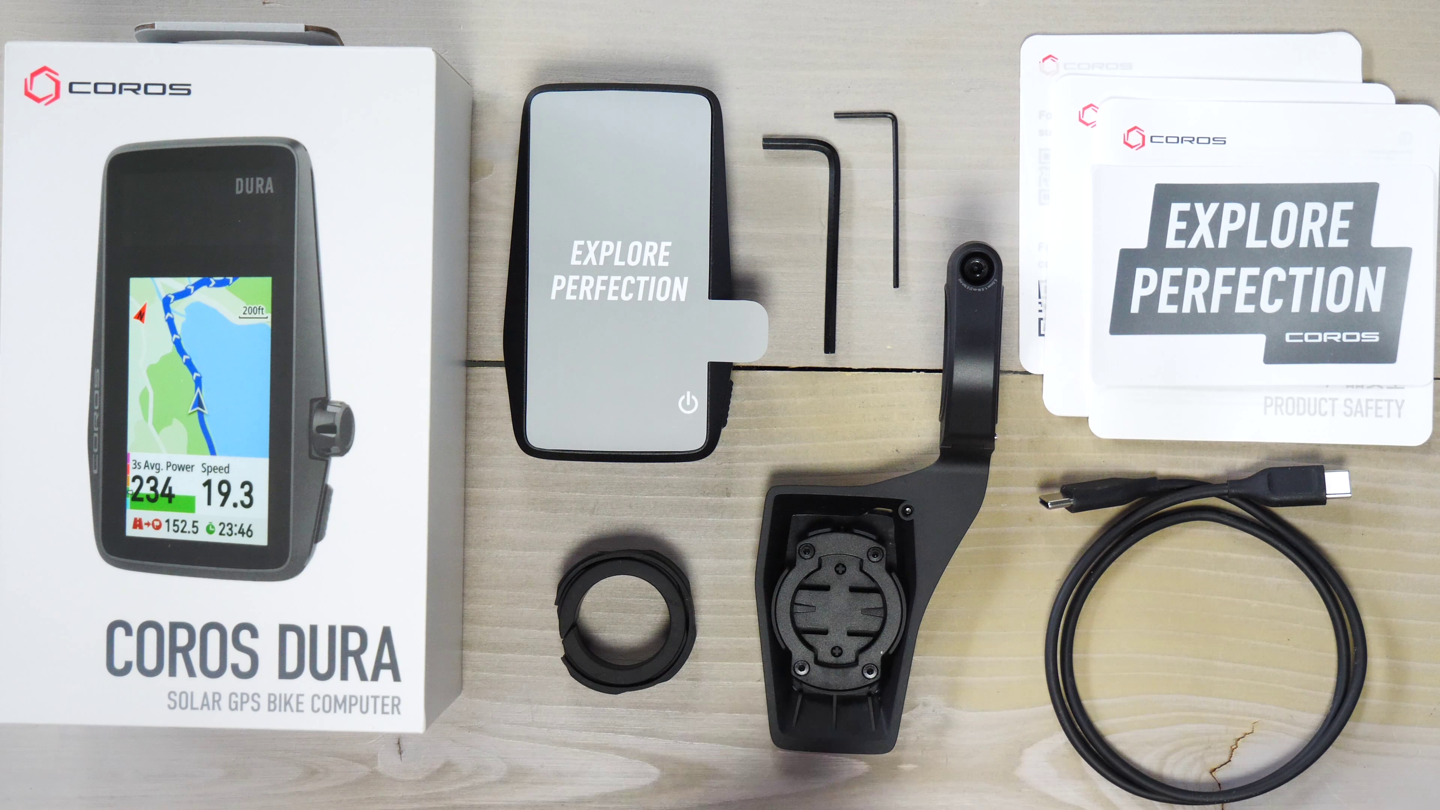
The COROS Dura is designed in much the same way as their watches. It shares the same software, same screen types, and same button-navigation type layout. If you are a COROS watch user, and were to ask whether or not the Dura has a given COROS watch feature, the answer is almost certainly going to be ‘yes’.
Here’s the quick specs though:
– 2.7” MIP touch screen
– Always-on, like a calculator
– Digital Crown and single additional button
– Weight: 97g + 44g for the included mount
– Out-front mount is Garmin quarter-turn style
– Has Dual-Frequency/Multiband GNSS
– Has WiFi & Bluetooth
– Has temp sensor, compass, barometric altimeter, accelerometer, gyroscope
– Has bike alarm feature
– Planned Safety Alert, Crash Detection, Live Tracking, Group Ride Features (not yet available/working)
– Screen mirroring to watch (not yet available)
– Downloadable/free maps (no street names/POI/etc…)
– Re-routing support if within cellular range with phone app connected
– Has training load & recovery
– Has structured workout support
– Has training plan support
– Integration with 3rd party apps (e.g., Strava, Komoot, TrainingPeaks, etc…)
– Battery life up to 120-hours for ‘All-Systems GPS’, and and 70-hours for ‘Dual-Frequency’ GNSS.
– Solar can extend these battery times, up to 2 hours for every 1 hour riding
– Bike profiles for Road, Indoor, Gravel, MTB, e-bike, and e-MTB
– Priced at $249/289EUR/399CAD/249GBP/449AUD/39600JPY/1799CNY
The exact specifics of some of the features not yet implemented are a bit fuzzy to me, such as the watch mirroring/handoff from watch to Dura, though they sound roughly similar to what Garmin and Wahoo both have, though both of those companies do things differently. Thus again, how exactly COROS implements it isn’t yet clear to me.
Probably the easiest way to think of this device, is relatively similar to a Wahoo BOLT V1, when it was introduced 7 years ago (March 2017). The features are basically the same as that, except with longer claimed battery life. The newer Wahoo BOLT V2, with all its current updates, retails for $279. So roughly in the same ballpark.
Some Riding Thoughts:
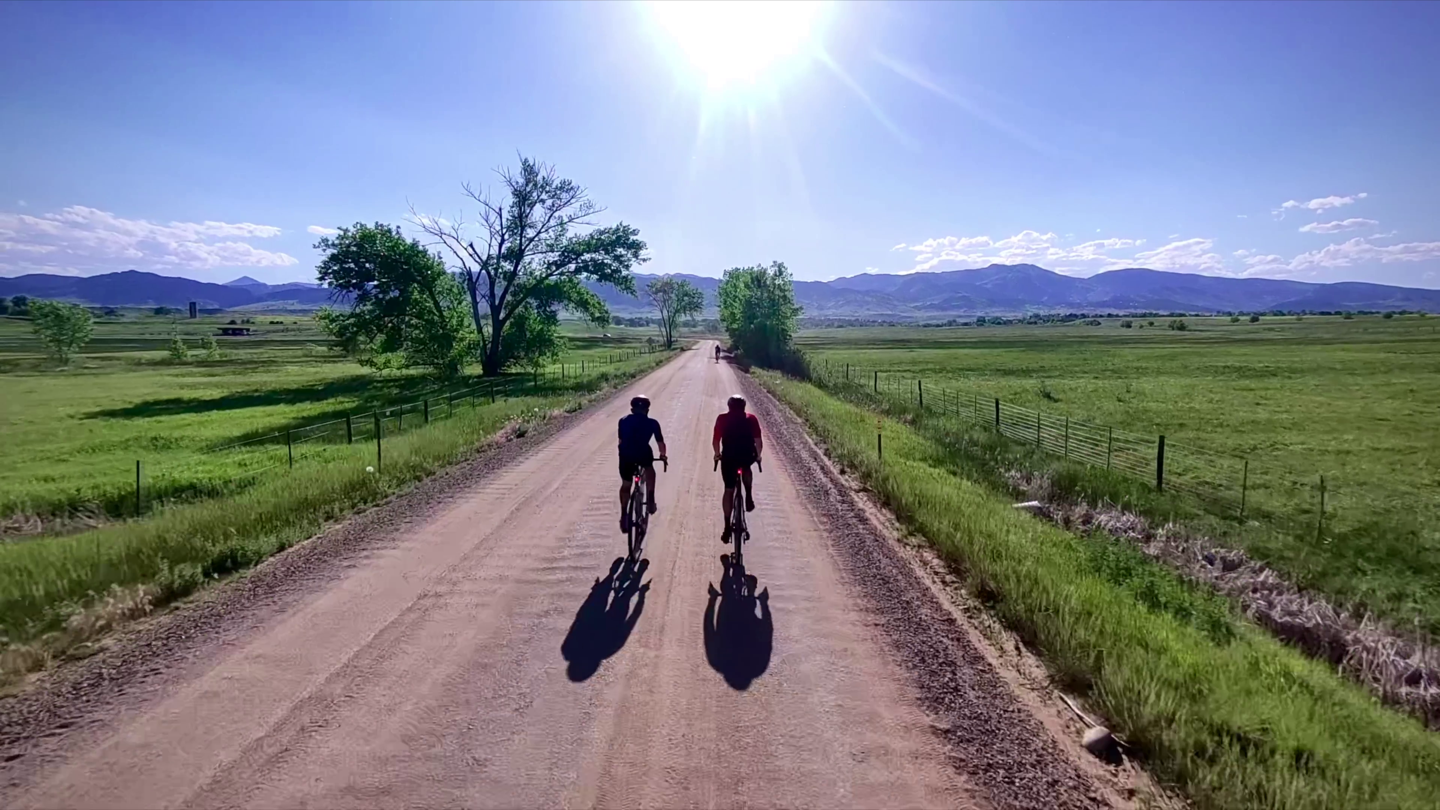
I’ve now gotten in a number of rides across various scenarios: Road riding, gravel riding, and mountain biking. Within that, I’ve had bright sunny conditions, dumping rain conditions, blah overcast conditions, along with sunset conditions. And from a terrain standpoint I’ve covered cities, flatlands, and straight-up Colorado mountains. TLDR: I’ve covered most usage scenarios, and can outline where things work well – and where they fall very short.
To get a ride going, you’ll simply hit a button on the unit to wake it up. The COROS Dura doesn’t really have a start-up period/procedure, it’s kinda like a calculator in that it’s just one tap away and always in standby. This is pretty nice to get started quickly.
You’ll choose which ride profile you want. Each ride profile can have unique data fields/pages. This is an area Wahoo lacks, so it’s nice to see the differences outlined here, where you might want a different ride setup for mountain biking than road biking.
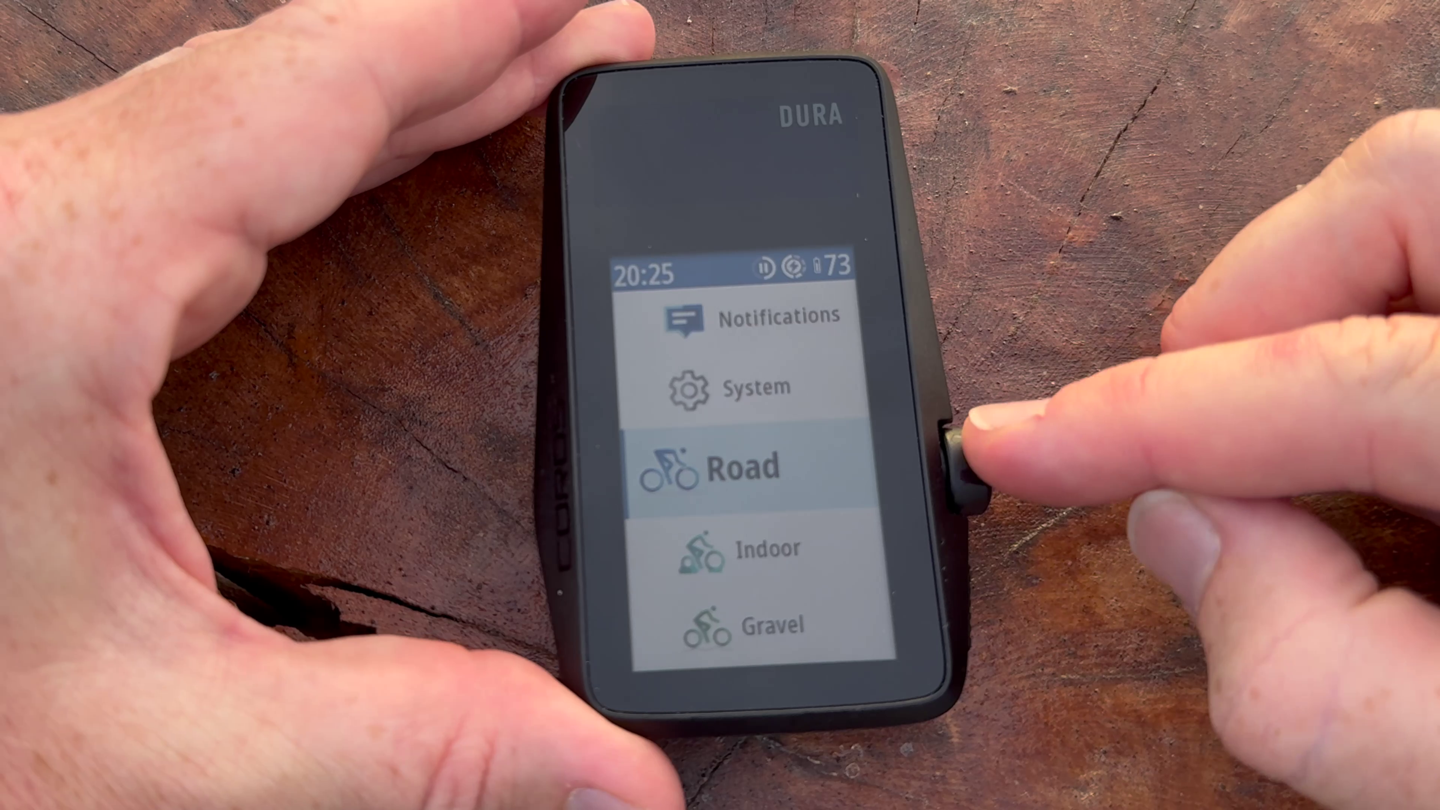
You’ll configure all these via the companion app, which then syncs to the Dura itself. There’s a number of different data pages and configurations available here.
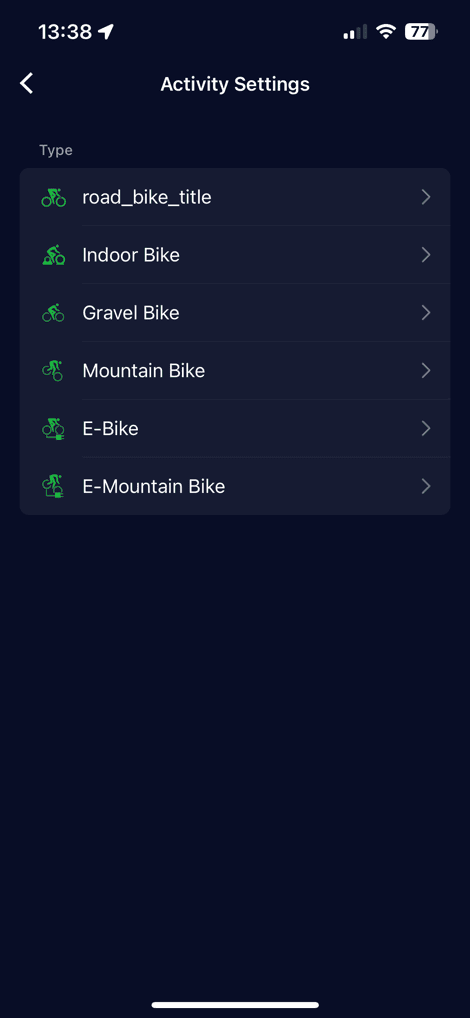
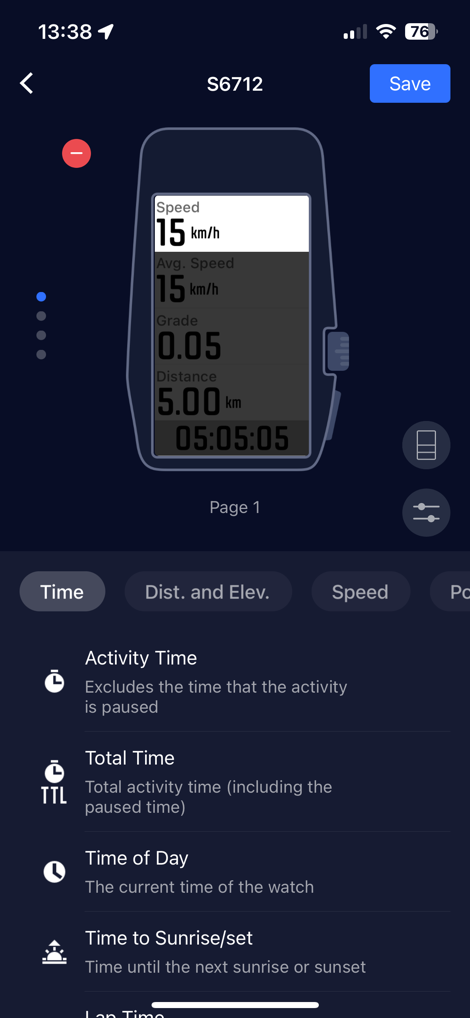
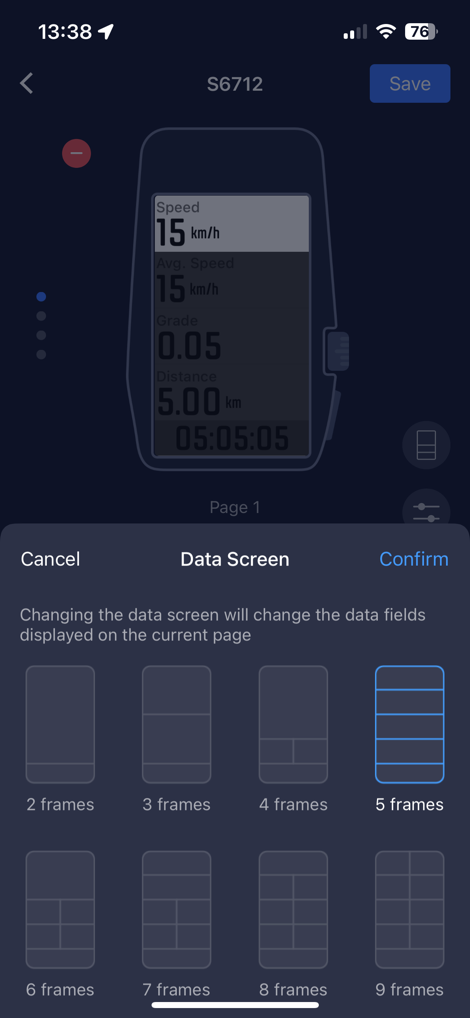
One unique one they have is that you can have a map page displayed up top, and then scroll through partial data pages down below (shown below, left). I like this idea, but equally, there actually isn’t a way to have a dedicated map page with dedicated display fields. Meaning, it’s either alway pages-split (map/fields for all pages), or nothing split (with no data fields on it). Hopefully my explanation makes sense, and it does sound like COROS is open to making this a tiny bit more flexible.
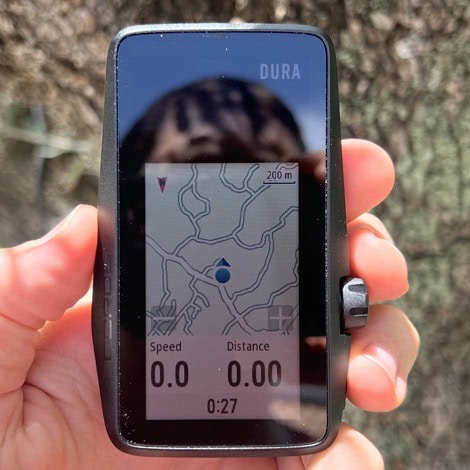
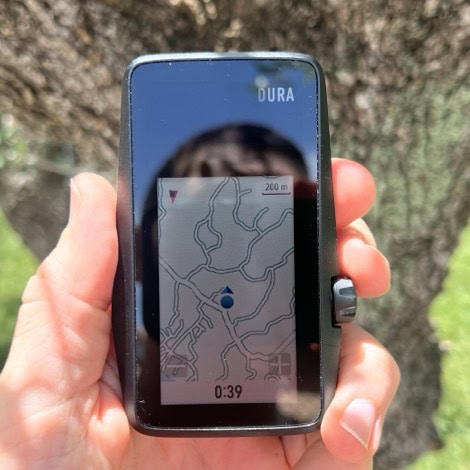
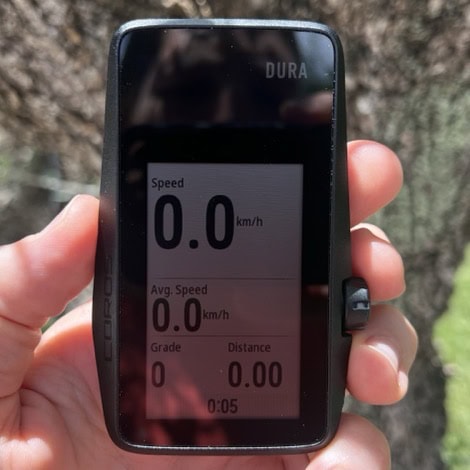
(Left to right: Split Screen view for all data pages, non-split screen map page, non-split screen data page)
In any event, from a navigation standpoint, you can push maps and routes to it. Maps will sync via WiFi, and you can easily choose which map regions to download, which are in nice small chunks. However, the maps do *NOT* have street names or POIs on them. Here’s how it looks on the map:
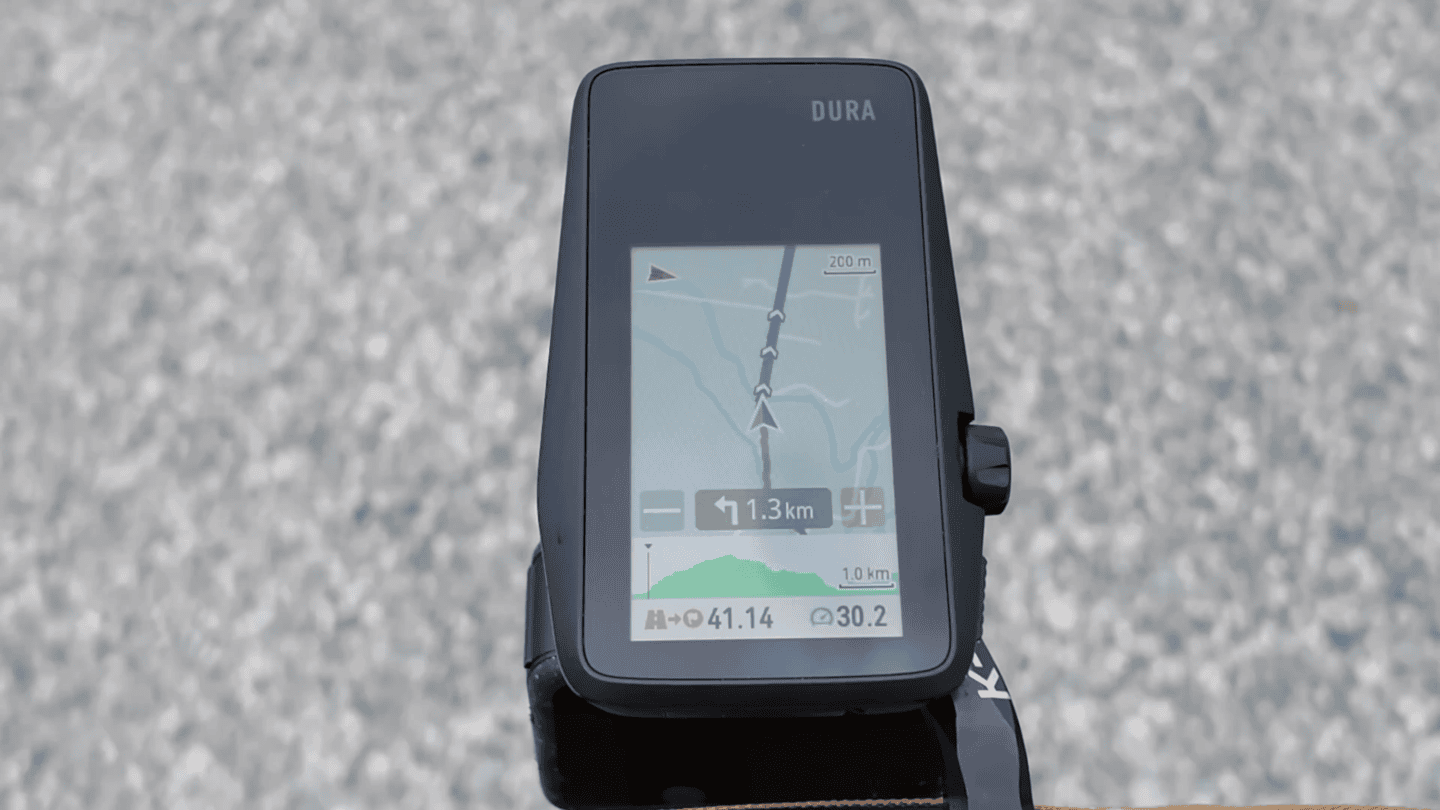
You can create routes via the COROS app, or import routes from Strava and Komoot. I’ve got a bunch of annoyances here, namely that you have to literally wait 3 minutes each time you import a Strava/etc route (it’s an actual timer), until it shows up to then allow you to manually sync to the Dura. It’s this lack of polish that’s frustrating, especially when you’re trying to get out the door and have to sit there and count to 180 seconds.
Once a route is imported, you’ll follow it on the map. It’ll warn you when a turn is approaching, but won’t show street names. I actually don’t really care a ton about street names. I’m constantly cycling in foreign countries, and can’t pronounce half the names anyway. As long as the turn directions are correct, then I’m good.
Unfortunately, they aren’t often correct. The routing parser on the COROS Dura will (very often) tell me with an arrow to turn left (or do a U-turn), when it means to turn right (and the line shows right). Here’s one of many examples of this in action (note the chevrons showing my upcoming route, and then the arrows giving opposite directions).
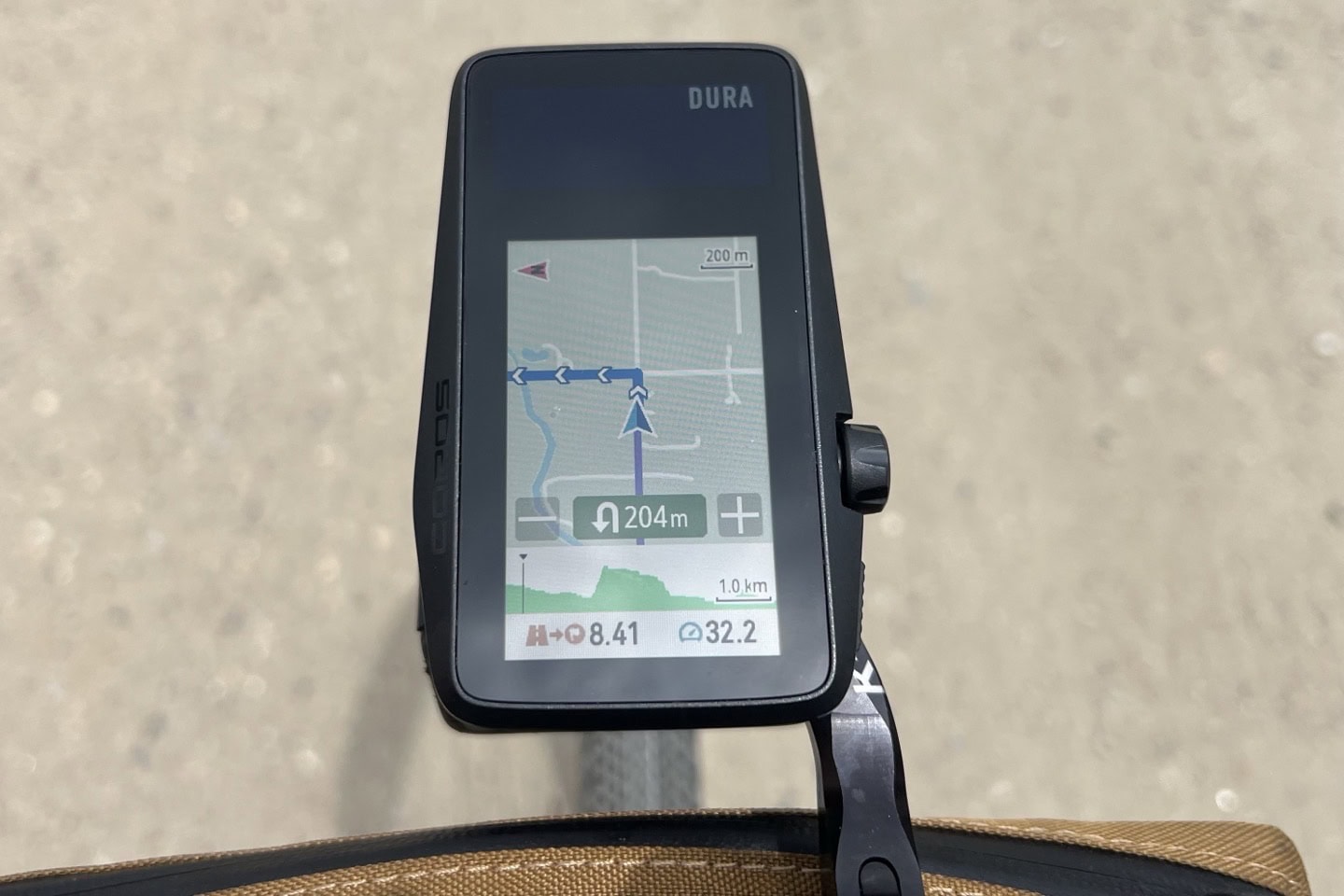
Now, this is where we get to the single biggest issue with the COROS Dura: Re-routing. Everything and anything to do with re-routing is very much not good. To begin, it doesn’t actually re-route until usually about 500-800m later (after a missed turn). That’s the first moment where it realizes something is wrong, nearly half a mile after you’ve screwed up. It’s at this point it’ll offer a prompt to ask if you’d like to re-route back to your route, or to the end destination.
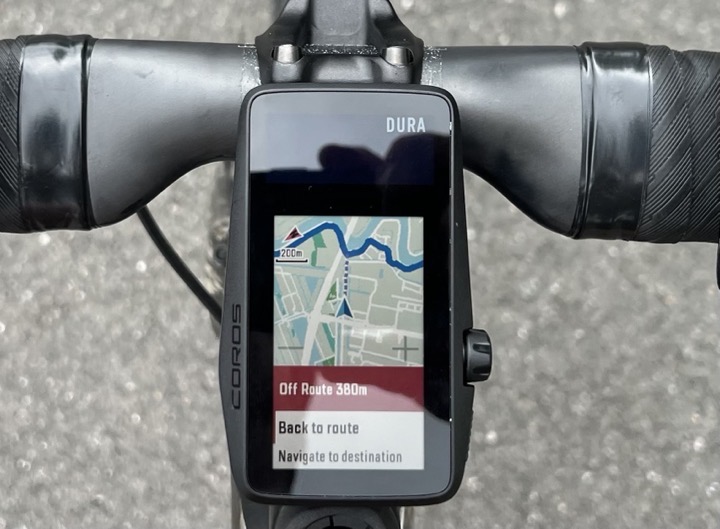
For one, bike computers should notice within 3-5 seconds of a missed turn. Then, they should just automatically re-route to make it work. Just like every other bike computer and phone mapping app does today. I shouldn’t have to wait minutes, then give it specific guidance.
But that’s actually not the biggest limiter. The biggest challenge is that COROS can’t re-route on the device itself. Instead, it has to go via your cell phone to Google Maps to get re-routing information. If you don’t have cellular connectivity, it won’t re-route. Or, if the app connection drops, it won’t re-route.
Instead, it’ll show a line, like this:
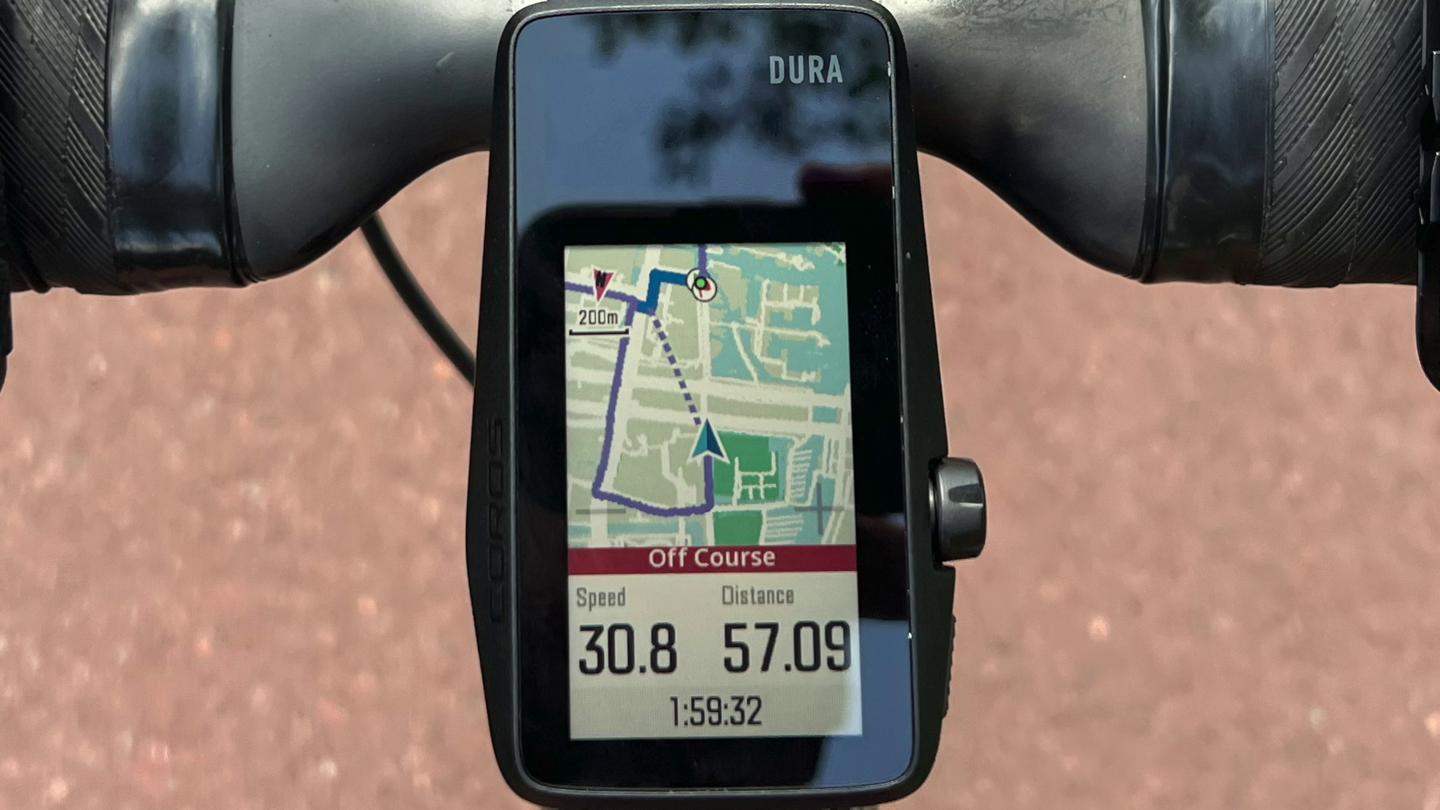
I’ve discussed this a lot with COROS. Their view is that in 2024, they believe that re-routing can be better done via the cloud, than on-device. And sure, that’s perhaps true if you’ve got always-connected devices. But the fundamental reality of a bike computer is that many people go beyond cellular range. In fact, especially the many gravel riders they sponsored for Unbound, which would frequently be in no-cellular coverage zones.
COROS says they aren’t opposed to offline routing longer term, but it’s not a priority right now. Keeping in mind that once a company starts down that offline routing/re-routing journey, history with other bike computer companies trying this (Wahoo, Hammerhead, Sigma) tells us it’s a 2-3 year process before that’s reliable. And those are companies with extensive experience as bike computer companies. Point being, this won’t likely happen (reliably) overnight.
When it comes to climb-related metrics, the COROS Dura will display upcoming climb details. But at present, it subdivides those climbs into a slate of smaller pieces, making it impossible to figure out exactly how long the climb really is. This past weekend I did a ~1,000m/3,000ft non-stop climb, and it was subdivided into 7 random chunks on the COROS. Whereas on the Hammerhead and Garmin devices it was properly listed as a singular climb. I tried loading the famed Stelvio climb in there, and it was randomly subdivided into 3 chunks (with zero parts including any flat pieces that might trigger a break).
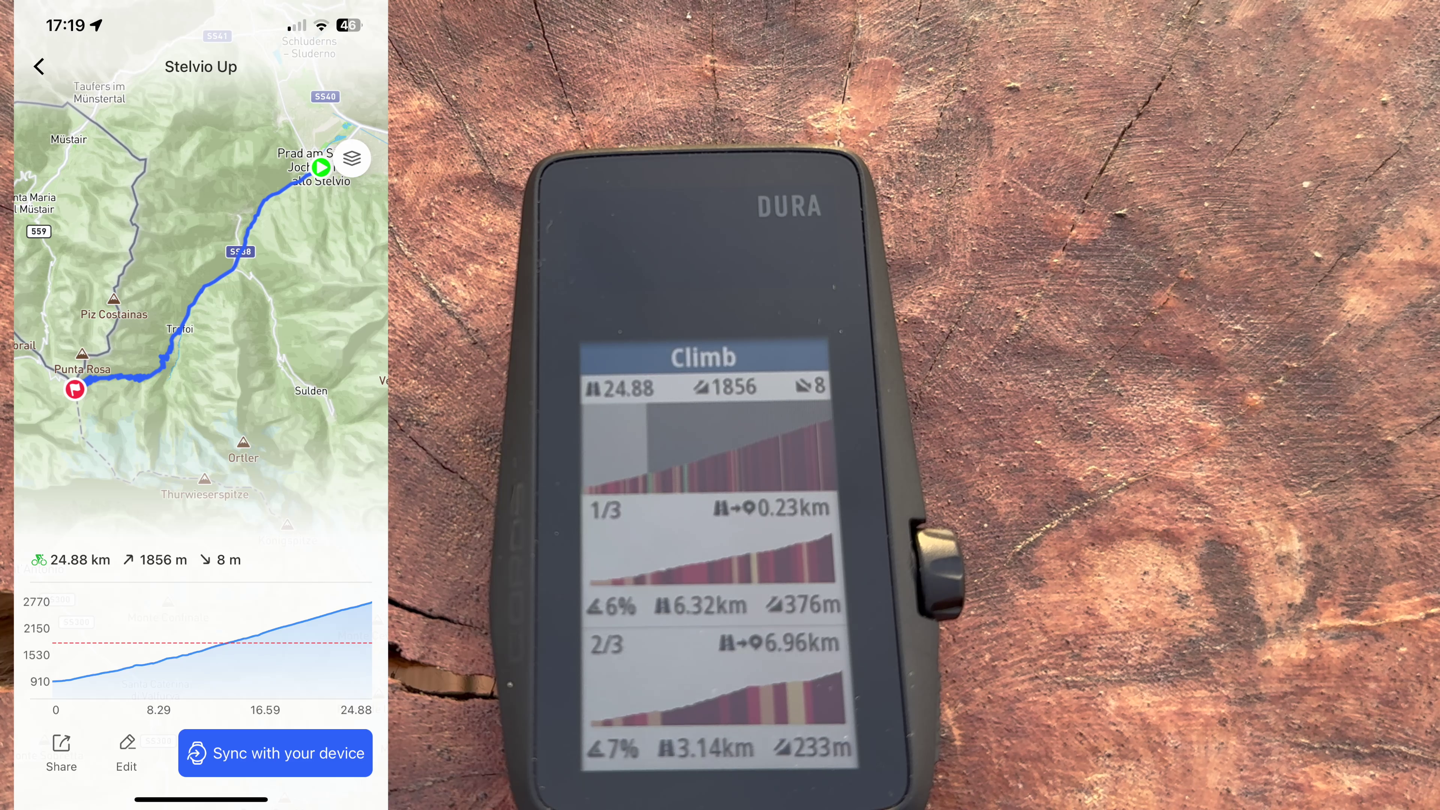
That said, the climb does look pretty along the bottom – I actually like how it’s relatively small and minimal here. If they can improve the climb splitting algorithm to be useful, this will be great (screen below has water on it, from rain):
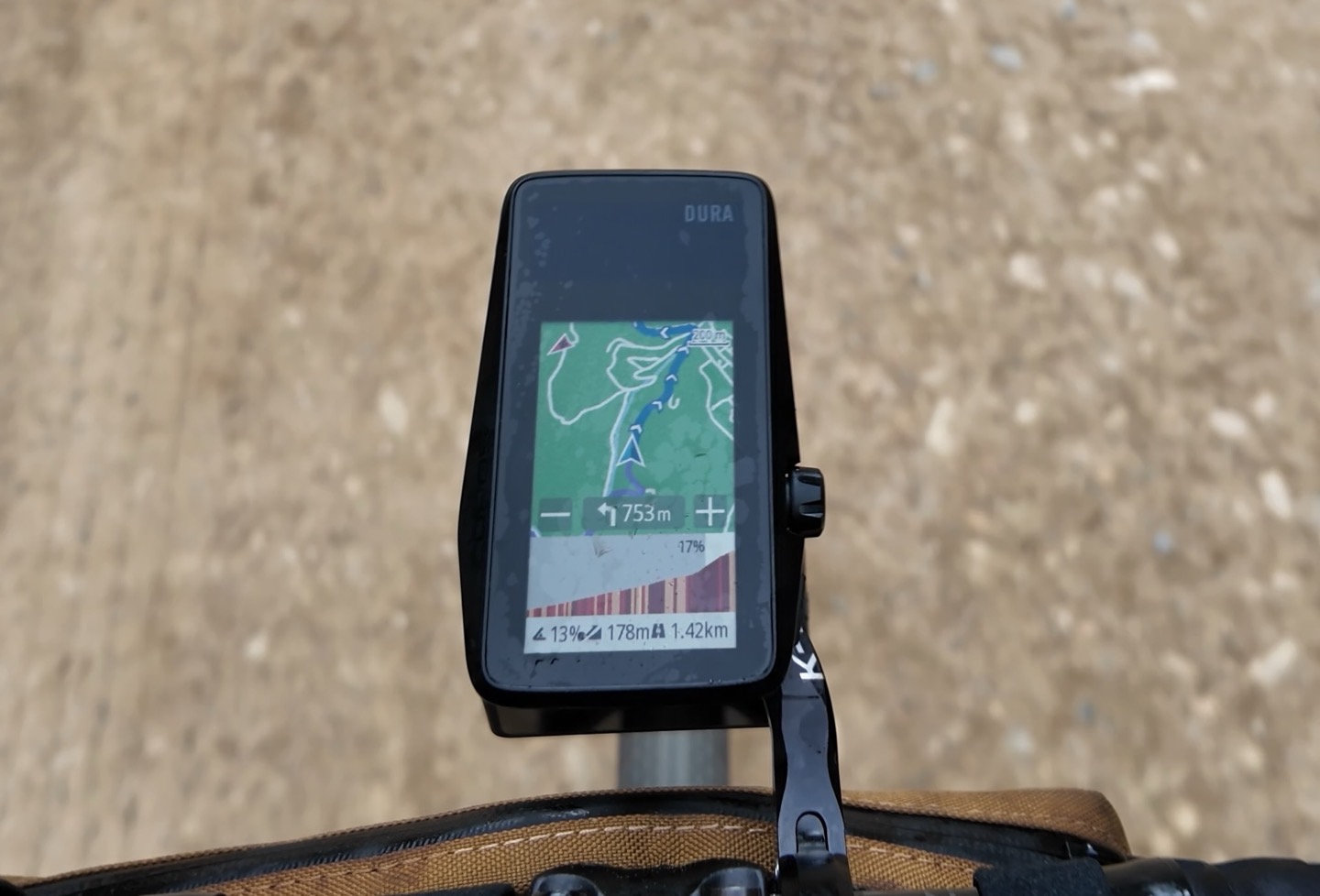
Beyond that, data fields work pretty much as you’d expect. I had no issues with pairing to either ANT+ or Bluetooth Smart sensors, including power meters, shifting (SRAM AXS), and heart rate sensors. Bike radar (e.g. Varia) pairing/functionality isn’t yet working reliably. But otherwise, you can see the data just like any other bike computer:
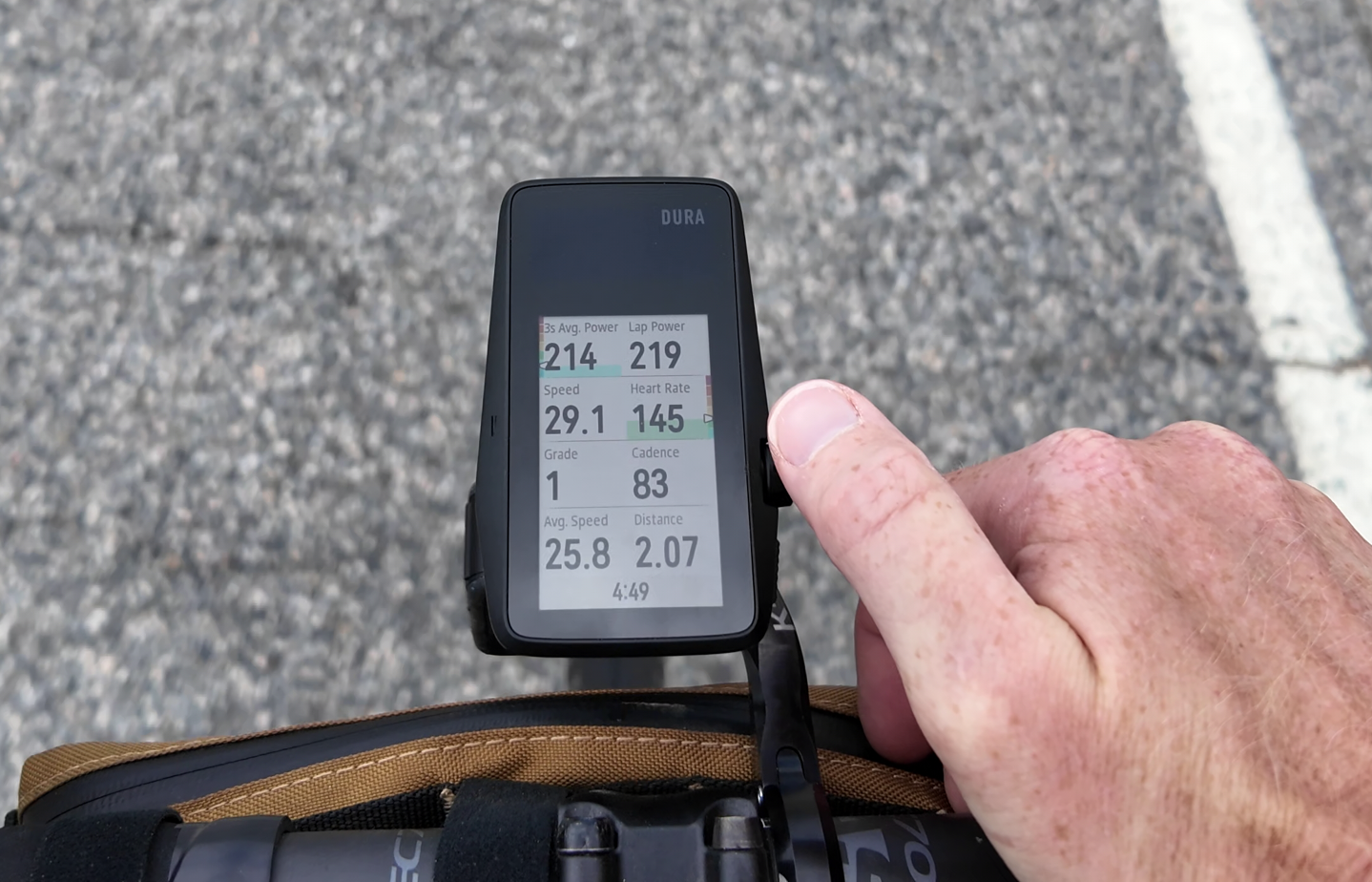
There’s a lot of big-ticket items that need to be sorted. For example, it can pair to ANT+ & Bluetooth Smart sensors, including power meters. But when I connected a power meter, the data is horribly wrong with so-called “Sticky Watts” (but the worst iteration I’ve ever seen of them), resulting in repeated values for 3-4 seconds constantly.
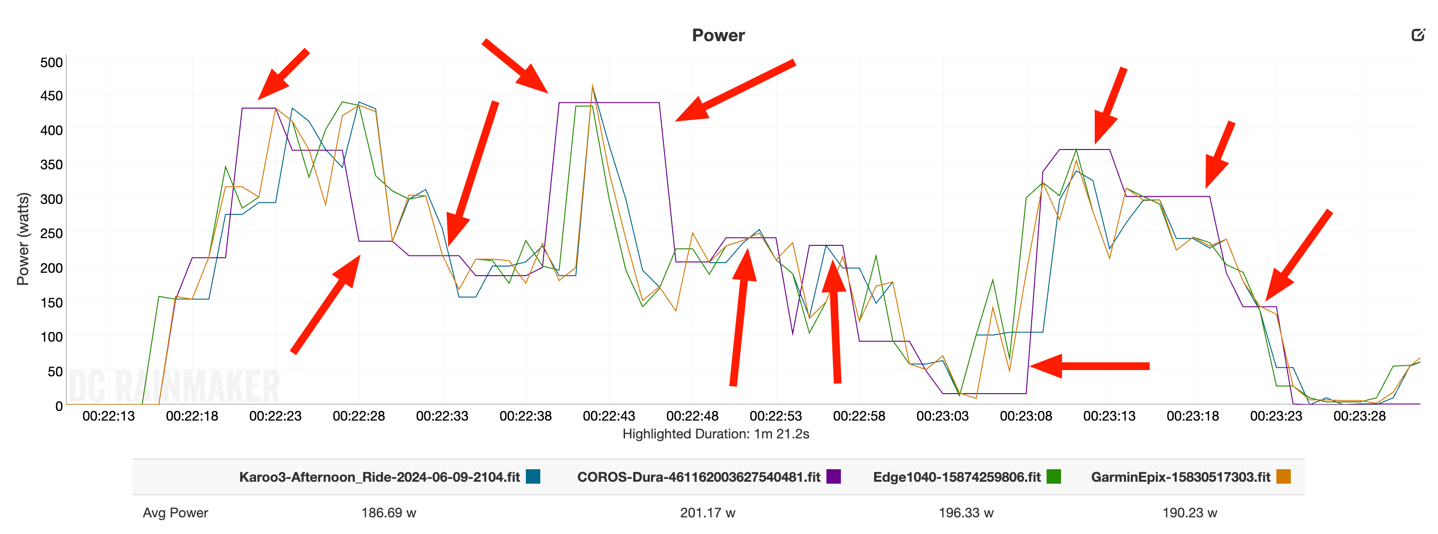
You’ll use the little scrolling wheel (Digital Crown) to iterate between pages. I’ll note my personal general bias against the Digital Crown (from any company), as I think it rarely provides much value compared to buttons on a sports device, except for zooming maps. My personal bias against such a wheel is maintained here, where it’s impossible to use on bumpy roads. As the only method to change data pages, that’s annoying to me. I don’t really have any issues with dedicated buttons on bumpy roads. But again, I note that some people like the Digital Crown, so my annoyance here might not translate to everyone.
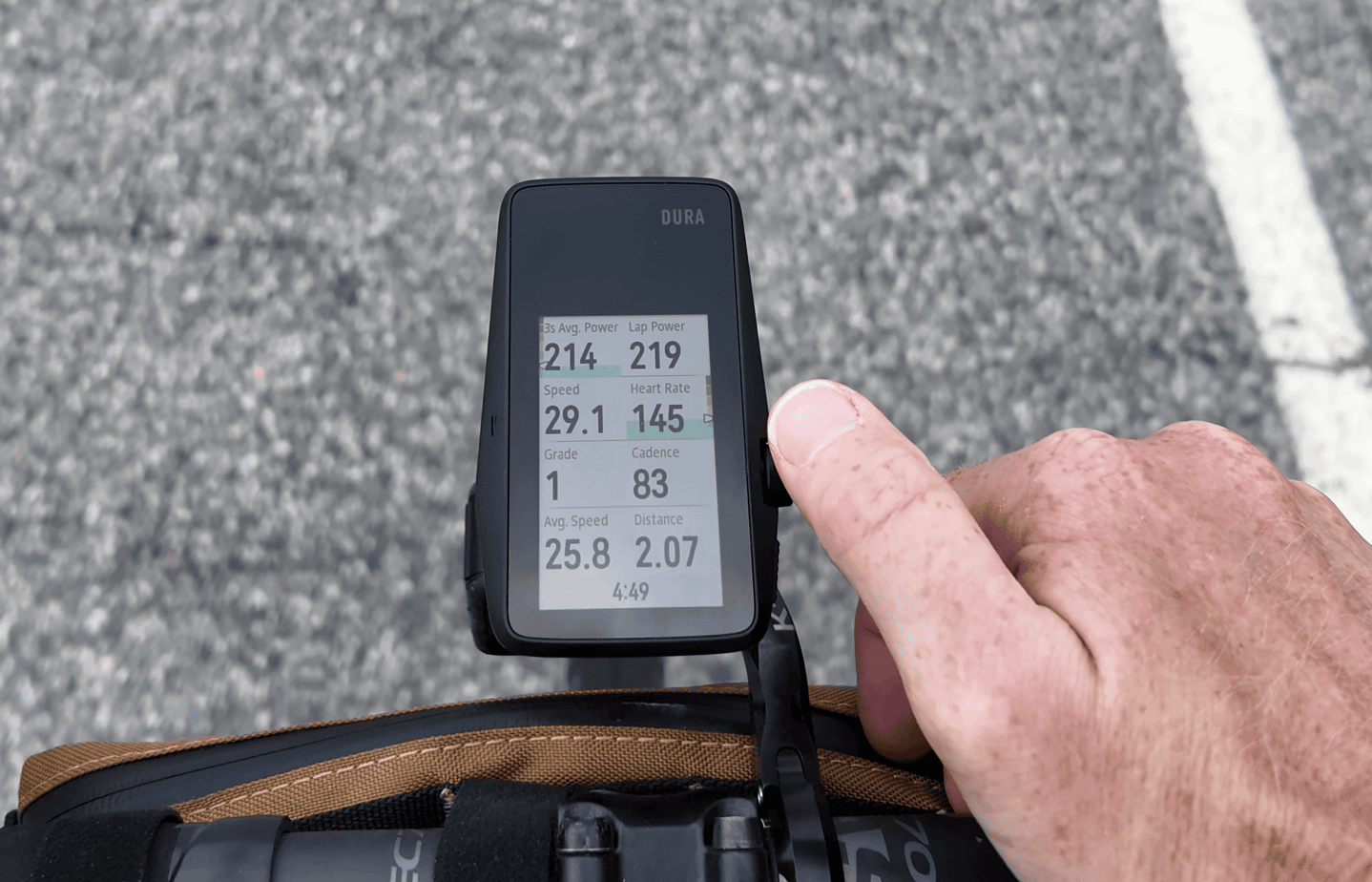
As far as battery life goes, the unit claims 70-120 hours, depending on GPS modes used. I’m unable to validate that claim at this time. COROS says firmware that includes battery enhancements won’t come until tomorrow. At the moment, I’m getting a fraction of that duration, burning roughly 3-6%/hour (in bright sunny conditions), so napkin math says maybe 25 hours of battery life in a dual-band configuration – which is on par with their competitors. I’m highly skeptical of anyone who has claimed they haven’t charged it in months and been riding constantly with it. That’s simply unlikely to be true (or, they haven’t ridden much/used much).
It’s important to note, that the summary screen of battery stats at the end of a ride, is actually incorrect on all current firmware (it shows completely bogus numbers). COROS confirmed this. Instead, in order to do battery math taking a photo of the starting/ending battery values from the main dashboard. I don’t see many reviewers doing this math correctly (or realizing this bug/issue). To be clear: This page here is, per COROS, simply spitting out random numbers right now:
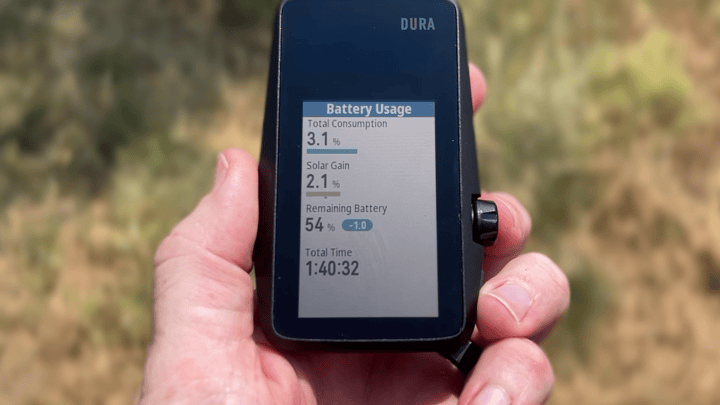
Still, if they can sort out battery life to their claims of 2 hours of battery time for every 1 hour of sunny riding time, that’ll be super impressive. To date, I haven’t seen that.
Hitting Pause:
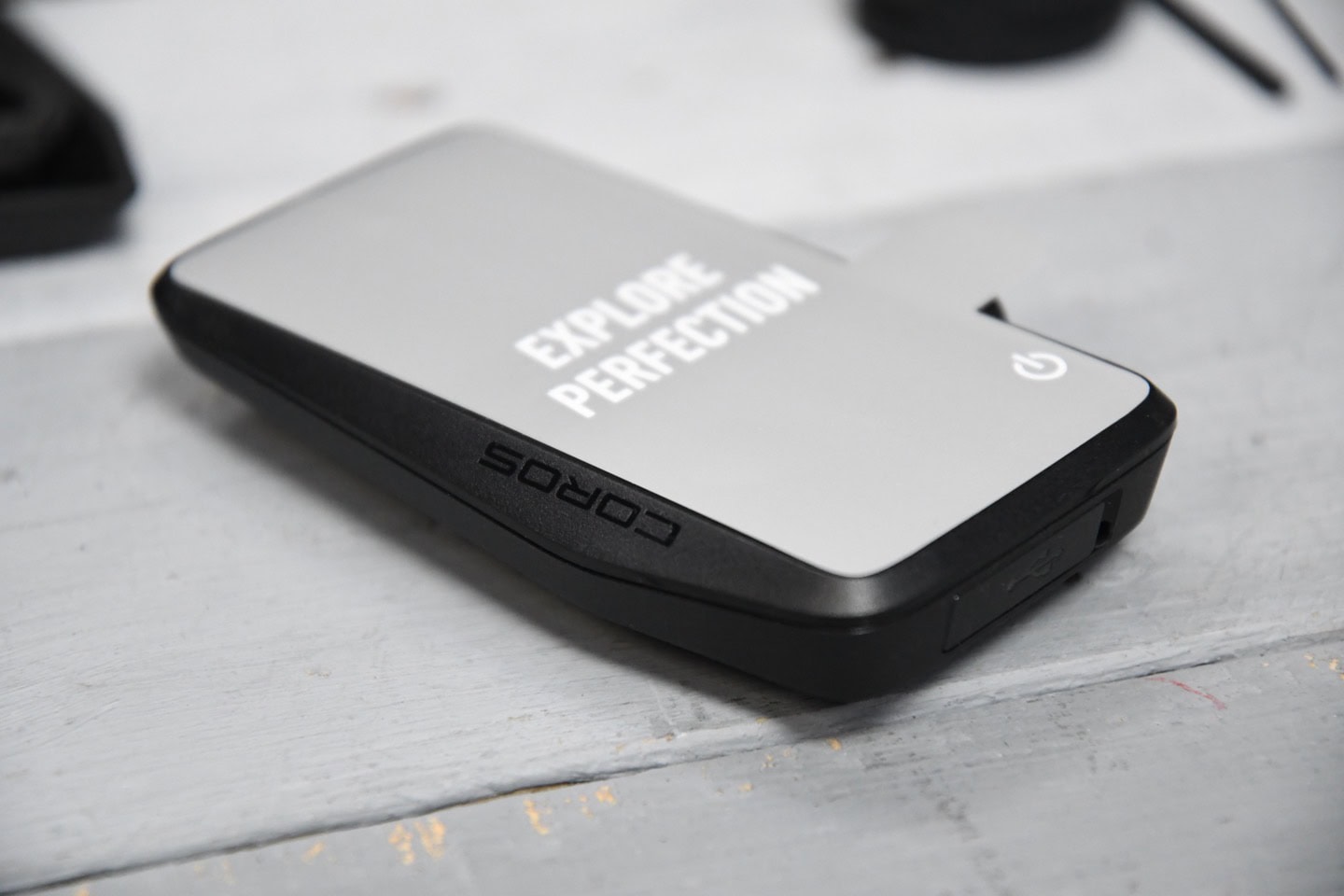
It’ll be interesting to see if/when COROS can stick the landing on the Dura. Certainly, they’re just at the beginning of their bike computer journey. Down the road in a year or two, many will have forgotten about the rushed launch of it, to seemingly try and hit the summer season. And likely, they’ll have sorted out many of the early teething pains by then.
But right now, it’s simply not ready. And I don’t see how it’s going to be ready in 3-4 weeks for the July 15th date. Outside of the power meter data I mentioned, other data like Shimano Di2 or SRAM AXS/eTAP the data is largely missing or incomplete. And in the case of cycling radar (e.g. Varia Radar), the unit disconnects.
The list of issues is vast, and that’s again, just to get it to baseline 2017 timeframe.
But if there’s anything that COROS is superbly good at, it’s updating their devices with software updates. And doing so frequently. They’ve typically aligned to a quarterly update cycle (roughly) for their watches, and historically have had good longevity in those updates for devices. I would *not* recommend buying this device today, but I think if I were to fast-forward to the fall, it’d likely be stable enough for tech geeks to toy with. And then if COROS can keep driving hard, then I suspect by next Spring, they’ll be in a position to be highly competitive with the lower-priced Wahoo offerings (e.g. the BOLT series), or other more budget-focused units.
I think what COROS has envisioned could be super fascinating, especially around battery life. It’s just a question of whether they can get to there, from here, and what sacrifices might be made.
With that – thanks for reading!
FOUND THIS POST USEFUL? SUPPORT THE SITE!
Hopefully, you found this post useful. The website is really a labor of love, so please consider becoming a DC RAINMAKER Supporter. This gets you an ad-free experience, and access to our (mostly) bi-monthly behind-the-scenes video series of “Shed Talkin’”.
Support DCRainMaker - Shop on Amazon
Otherwise, perhaps consider using the below link if shopping on Amazon. As an Amazon Associate, I earn from qualifying purchases. It doesn’t cost you anything extra, but your purchases help support this website a lot. It could simply be buying toilet paper, or this pizza oven we use and love.






















That’s a shame. I have used most computers from the big manufacturers (Bolt 1 & 2, Karoo 2, Edge 130,500,520,530,540,830). At the moment I am back on my Bolt V1. It just works for me. And the reason I use it is because its rock solid. I don’t have a particular ecosystem reliance – I use an Apple Watch Ultra as my main non-cycling device. My perfect computer would be similar to the old – now unsupported – Wahoo RFLKT+ – a screen with solar charged battery with infinite longevity (highly unlikely in the UK) which mirrors my phone or apple watch and bridges in my ANT+ and BLE sensors.
What about their footpod and Effort Pace metrics? Was that even useful for Coros users?
Hi Ray,
Out of curiosity – is it possible to configure the unit for the first time just on the device itself (without any accounts or Wi-Fi, obviously), but at least set up a profile with data fields on the device itself and go for a ride (both Garmin and Wahoo can do it, AFAIK, albeit to a different extent) or is phone-based configuration a must?
According to the review by German page rennrad-news, you get a fullscreen QR code to pair the app, with no option to skip it.
link to fotos.rennrad-news.de
What about their footpod and Effort Pace metrics? Was that even useful for Coros users?
Reminds me of my old Edge 705 (searching for which, incidentally, was how I first discovered your website)…
Most club cyclists I know cycle about 15-20hrs/ week.
So the “forever” battery is chasing the <1% cyclist I feel.
Ray, you are not alone in regard to digital crowns. I don’t see a point in choosing this over two simple buttons.
COROS’ big problem is that it makes the same mistakes over and over again.
They knew Dura wasn’t ready but they still shipped media samples they cannot expect to receive positive or even neutral press from reviewers when the products are so far from completion.
Why do coros still not understand that negative press = good press? They should have moved media announcement to July 15th, no reason to release the news today. It now gives Garmin, Wahoo, and others 1 month to prepare retalitory marketing tactics and get a head start on any new features. Just dumb strategy from coros.
Many of the issues noted above are fair and are unlikely to be fixed any time soon. This will create a negative vibe for prospective customers many of whom won’t bother with a dumbed down version of the ELMNT V2 Bolt atleast not for the next year.
Its true that they rushed this out the gate for summer but its been in the pipeline for the past 3 years. They could of and should of planned this better.
its clear as they get older and cockier the CEO cares less about the brand;s image and more about getting things on the shelves. Otherwise there would be NO reason to release samples to media with so many glaring issues. Good point also about it taking them 2-3 years to bring cloud mapping updates, this will never happen, and they will be forced to bring routing offline or miss out on thousands of customers, similar to their messups around ant+ in the past.
Knowing that decathlon is now a big shareholder in Coros I think maybe if Decathlon made them bring the release date forward to get summer sales and enough footing in the market for Christmas season? Or maybe their CEO in china is now just so madly unhinged that he thought it’d be fun to make things as difficult as possible for the company? D.
It’s an interesting product for a niche user group, ultra-distance cyclists and bikepackers. They need long autonomy, and don’t have access or time to recharge their unit during a multi-day outing.
The product page talks about a “checkpoints” function that could meet the specific needs of ultra-distance races. The absence of a POI display during races is a major shortcoming on my Wahoo and the other units I’ve tested.
Is this enough to attract ultra cyclists and bikepackers? There aren’t so many of them, and they’re already equipped with GPS, solar panel or dynamo hubs.
But it’s a differentiating factor compared with other GPS units that are more road-oriented (lack of points of interest). It’s good that a Coros is taking an interest in this segment, as other brands don’t develop ultra and bikepacking specific function.
To be fair, Bikepacking.com (which very much aligns with the ultra-high battery life claims) gave Dura a very positive review practically praising the computer. On the other hand – I don’t think I can remember a single review there that was negative towards the product being reviewed, so take it with a grain of salt.
The bikepacking market is tiny, like less than 1 in 10 of all cyclists. any cyclist thinking about bikepacking (even before bike touring) will already have a very suitable bike computer.
The real reviews will speak for themselves. Long battery life is the only standout feature here. Everything else is commonplace and expected. The features that really matter will take at least until this time next year to properly iron out. Cyclists don’t want trial and error and halfway products. They want things that work especially if you’re trusting your life with it to get from a to b.
You have to bear in mind that the review on bikepacking.com and similar sites are not real reviews either. you’ll notice that most editorial publications that have an advertising arm as part of their business will never overly negatively rate a product to the point that DCR does. BikeRadar won’t give any product less than 5 stars if it sees an advertising future with that brand/company. Plus all these magazines benefit from giving positive reviews by receiving affiliate income. Take it with a grain of salt 😅
One of the slightly entertaining things about receiving press/media reviewer kits (all the documents) from all number of companies, is seeing which reviewers basically copy/paste things. As if following the actual posted presentations. Not talking specifically COROS, but actually any of number of companies.
There are certain lines in presentations that are basically copy/paste to some of the reviews out there.
As GPLAMA highlighted in his video, the comparison chart provided in that media pack, unfortunately, has many errors on competitor products. Some, quite significant errors. Inversely, I will give COROS credit that they did at least include a few lines in those charts that show COROS not having a given feature (most companies just skip over those lines entirely).
I doubt they are targeting “ultra cyclists and bikepackers” at all. That’s too small a market.
The need to have a connection to do rerouting would likely be a deal-breaker for this group anyway.
There are many casual cyclists who have a cycle computer that runs for months on a battery. The Dura might appeal to this much-larger group. There might be enough of them put-off by needing to recharge frequently and the typical higher-price of these kinds of computers.
Why do you thinking bikepackers would already have a bike computer? I still don’t and I’ve been bikepacking for a while now. Nothing (until now?) has a battery life that makes one useful.
I’m not 100% sure what their target audience is (except for Choros watch users of course) but I’d be curious to see how many potential customers would actually prefer a smaller more sleek device over the big solar panel?
I might be in the minority but I’m not willing to spend a ton of money on a clean, integrated cockpit just to put a hideous GPS unit up there.
In my opinion, the unit is not intended for roady, but for ultra cyclists and backpackers. A solar-powered GPS with several days’ autonomy could be an interesting alternative to a dynamo hub, AC-to-USB rectifier, buffer battery, etc during summer time (long day, no need to ride at night).
My dynamo setup must cost more than 500€ in total to be fully autonomous in lighting, navigation and phone charging. This is hard to justify for someone who doesn’t ride at night.
Is that a total available market of 100,000 people or less?
So the ultracyclist backpacker that only rides within urban areas with cell phone coverage. Oh and the backpacker/ultrarider that is interested in seeing 8 data fields of power, balance, cadence…
We could have saved a lot of time from Ray, des, etc doing all the reviews and simply asked Bernard, the unique person in the world this is for if he likes it.
But seriously, this is a prime example, noting Garmin is not much better, of people releasing half arsed products nowadays and then using the paying public to do their bug testing, wait for the patches to be sorted and pretty much by the time it’s in the ‘fit for purpose’ category then the company is telling us that we need to upgrade to the newest half designed ‘thing’. /grumpy_old_man
Well said, your last paragraph. I almost (I am in fact) loosing interest in these things I started not to care about time and distance for my running and cycling. Navigation is the only interesting part for me. If not I like to leave the tech home. Tech overdose.
“ultra cyclists and backpackers”.
Needing a phone to reroute says otherwise.
It’s more likely targeting more-casual riders (a much bigger market) who are used to having a cycle computer that runs for months on a battery and are put-off with needing to regularly recharge a typically much-more expensive device.
Even if it functioned 100% perfectly – that thing was dead in the water with that giant forehead/solar panel on it. I know long rides are a thing…but how many people need 100s of hours of riding without a charge? Maybe a few % of riders?
Wahoo can’t get a watch right and Coros can’t get a bike computer right. Maybe they should join forces…
You have forgotten to add that Garmin can’t get both (watch and bike computer) right :)
It’s well known across industry folk that about a year ago (now) Wahoo had asked Coros to build their next generation GPS watch based on the Coros framework of hardware and software. This will be similar to how Decathlon labelled up its two GPS watches based on the Pace 1 hardware and software.
Personally I don’t see how wahoo could make another product that doesn’t suck ass by itself. There GPS watches are notoriously rubbish and their bike computer software is poor and lazy.
Coros are making big gains if they accept the wahoo deal.
At least 250 currently doing the Tour Divide: link to bikepacking.com
And the guy that won Unbound XL is currently, or will soon, riding another Divide from Norway-Russian border to Portugal or Spain (have not looked up the ride).
Dozens, if not hundreds, of rides now last multiple days.
The market exists. Should the software be more complete? Sure…
They’re doing these rides currently, and the Dura isn’t out yet. What are they using now? Why would they switch?
flat out not true. I absolutely promise you that Wahoo did not ask them to do this.
*their
Just continuing discussion. I get that there are people doing these things. But I don’t understand how the Dura fits. It has to use a mobile phone to connect to the internet to do route mapping (I know if you stay on route then its all offline, but in that case a paper map has infinite battery life). So having a 100hour headunit that needs a mobile is not that helpful (unless they bring back the nokia 8210).
When I was bikepacking I used a simple wired ‘computer’ that had speed and distance. 3 year battery life. Navigation was a photocopy of a map with the route in red pen and a turn list with the elapsed distances noted.
It will not be as good as Garmin’s offline maps, but it’s not as basic as a paper map. A paper map has no turn by turn navigation, elapsed time and distance, speed, alerts when you go off course, waterproofing, etc.
Do you know – where does it source the map data from (specifically for single-track mountain bike trails)?
I think the main focus is on road cycling but in any case the computer will be receiving gpx routes loaded by the user, followed by cloud rerouting from google maps.
There’s no feasible way for them to be able to get map data for single track without an apk from something like AllTrails which they don’t have.
It sounds like as they’re relying on online rerouting/Google maps, that off-road rerouting and map/route creation is off the cards for now.
Even if this doesn’t completely succeed, it’s likely to push Wahoo and Garmin to extend battery life even more. That can’t be a bad thing. Realistically, Garmin didn’t have a bike computer that would reliably outlast an Unbound XL of 350 miles for an average cyclist until the 1040, 840, 540’s came out in 2022. Further, it’s pretty clear to me that the gravel end of things and ultra distance events will continue to grow at rapid pace. The battery claims of the Dura, if realized, would be a godsend for a Tour Divide rider.
Yeah, I think the battery life, if they can hit it (without all sorts of other sacrifices) is cool. Though, I think people forget you can get 100hrs with the Edge 1040 Solar in regular GPS mode. And I find that Garmin has actually gone rather conservative on their Edge battery testing. Almost all my results see better battery performance than their specs, using the exact same settings as their specs (this is largely owed to how upset people got after the Edge 130 specs were all wonky, Garmin changed a lot of their policies on this).
Battery Spec/Testing table for Edge 1040 Solar: link to support.garmin.com
It looks like the evolution of the Cateye Solar CC-2000.
And that’s not a good thing.
Things like this get killed in reviews because internet reviewers forget to look at value. Value is the first thing to be forgotten when you don’t have to buy these things yourself. Coros purposely kept the price low. Of course it’s not going to be as good as a Garmin 1040. In the same way that a Toyota Corolla isn’t as good as a Ferrari. A Corolla is going to be perfectly fine for 80% of people 99% of the time though, and they can save a ton of money. You can buy 2.5 of these for the price of one Garmin 1040.
Value?
What, exactly, is the “value” of all these features, compared to a fully functional Wahoo BOLT V2 for $279 (and often sub-$250)? That’s a mere $30 more and includes something thats fully functioning, today, with mode features, proper re-routing, proper sensor support, and everything else.
Or for the same money you could buy an Edge Explore 2, which actually tells you when you miss a turn and reroutes without a phone connection.
There’s no value in an inexpensive computer that doesn’t do basic navigation well.
@Ray is the value also not a ceo directing and personally attacking you? Haha
I’d paid extra for that tbh lol
Yeah but the explore 2 is running on windows vista beta and can’t process even turning on. You’re better off with a wet map.
Not my experience. 2 years regular use, reliable navigation, no issues.
As battery charge goes , if you have the budget and you ride in the evening /night. You should definetely goes the dynamo/usb charger direction. I run a SON SL with a sinewave reactor on the stem cap. I have a Garmin Edge 1040. The battery level actualy goes UP as I ride along. I have to say that I mostly ride in the evening
or at night; rarely do I ride during the day. So the SON Edelux II and SON tailight are always on. And even with lights running, the battery level still goes up.Sometime the garmin notify me that I have lost outside power (the SON cache is empty) but it never last more that a minute or 2 then the charging start again I never EVER plug the garmin in the wall outlet at home. So for me battery life is a non issue.I have put a screenshot of the battery level of my latest ride. I left the house at 8:30 pm in the evening to start the ride.
Yes it would be great for a Tour Divide rider or Unbound like we’ve seen but the reality is that those cyclists would also need to be using the Dura all year round as well as their computer (esp if they’re a sponsored rider) and no cyclist in their right mind will use dura over what Garmin offers in terms of training features.
It’s all good for battery life, but everything else sucks (pre-release) and as others have said will take at least 2 years for the company to straighten out the issues so there’s no reason why pro cyclists would adopt coros at this point. I feel sorry for Freddy and other pros who have been approached for loads of money to rep dura only to find that the product is trash and not what they were expecting in comparison to Garmin.
Still all competition is good competition and hopefully it will make Garmin think twice about their new lineup.
Ray,
Typo here:
“This past weekend I did a ~1,000m/3,00ft non-stop climb”
Must be 3,000ft?
Thanks!
Just as a general reminder, I ask that people use the same name (whatever that name is) when making comments, rather than posting under a new name for each comment. I’ve reconciled those comments under a single name.
It’s still not the product I’m looking forward to. ehh Not enough data on the map. Wahoo is currently the best. He is a role model for me.
I am an ultracyclist and ultrarunner. I have Coros and Garmin products. For racing, I hate rerouting because I have to follow the correct route or be disqualified. That said, for all those folks saying this product makes no sense, you guys do not understand Coros. They focus on ultra folks, that is their market. Seamless integration with radars is nice for training but we also do not use Varias in races b/c the battery life is too short. Dynamos cost a lot, you need a different one for every bike and they cost watts.Our existence revolves around batteries and food. Literally. I wish Coros had worked out some of the bugs beforehand but I am super interested in this item. Seems to me like they know their target audience…and the price is WAY better than Garmins 1040 solar. I will wait for some software updates to get things sorted then probably get this, assuming the battery life does reach their claims after the updates (which is how their watches are- with every update, you get an immediate upgrade, more features, etc).
Worth remembering that the 1040 screen is much larger, as is the feature set. So comparison is tricky and only possible if your sole requirement is battery life, which then maybe is the Ultra athlete, as you said.
I use the same front wheel with dynamo hub, for road and gravel. I can even use the same wheel on a QR 9 x 100mm with an adaptor. The only time I’d need a second dynamo would be for a 15×110 MTB axle.
In most cases it’s not necessary to have several dynamo wheels. The dynamo offers an autonomy and a flexibility in particular for the lighting incomparable with the batteries. More GPS autonomy is a good thing, but it won’t make dynamos obsolete.
It’s perfectly possible to recharge the varia during the day on the dynamo and use it at night. The alerts are particularly useful when you start to feel tired or lose your lucidity.
Proper Garmin comparison would be the 840 (Solar) not the 1040, so that narrows the price gap considerably (especially with the recent/current discsounts on Garmin).
Speak for yourself. I’m also an ultracyclist and always use a Varia. Vast majority of my ultracycling friends also use a Varia. The second I saw Ray mention issues with the Varia I lost all interest in this unit.
I ride mtb, gravel and road ultras. I need 3 separate dynamo wheels to cover that, which is very expensive. I also weigh 52kg. When you take away 3-4watts using a dynamo, that is noticeable over 1000+km. Additionally, as convenient as a dynamo is, there are routes where you really do not get much power. I rode a 1000km with 20K meters and most of the guys with dynamos said they were just getting a trickle…nobody on the pointy end had a dynamo. Not saying dynamos suck, I have one on the road bike, but there are a lot of instances where going without is a big plus and at the battery life of the Dura, I think we are getting into territory where you do not need a dynamo anymore if you have a quality battery lighting setup. The Garmin 1040 solar is an amazing computer too…but it is also much much more expensive and I believe also larger (which may or may not be your thing or might cause setup issues in your cockpit). Knowing Coros, they will make 2 updates and all these problems will be fixed. At that price point, I think a lot of people will be switching over after the bugs get sorted but we will see!
I would agree that for road cycling, the Varia is really a nice-to-have but mine only lasts 6hrs and drains my bike computer battery like crazy. I do not know anyone using the Varia in races (but this is of course not statistically relevant- only my experience). I have lots of Garmin products and Coros products and admit, Garmin has a much better range of functions and puts their products on the market finished. This is what I think Coros does wrong from a marketing perspective and if you are unfamiliar with their products, you will not know but they do updates very often and everytime they do a software update, you get more features on top of the bugs getting sorted. Whomever at Coros gave Ray this unit prior to checking “the basics” should have thought twice IMO. Their mistake on that one.
Not a single word about the childish idea of adopting the “Dura” name? Maybe they launch their own radar under the name Ace as well?
“Explore Perfection”…where perfection is the perfect storm of poor decisions that were made during this product’s design, production, and launch date timing.
From my aesthetic point of view, this is really the ugliest device I have seen in a long time…
Hi Ray, did you have a chance to review iGS800 by igpsports?
worthy competitor to other brands, having 3.5″ color touch screen, 50 hours battery life, dual band satellite. cant find much reviews online at the moment.
thank you~
Abysmally bad according to almost all reviews/commentary.
Needs the internet and a cloud for rerouting?
No chance I will every pay for such a device. To make it clear, why should anyone buy a *DEVICE* if it cannot do the task autonomous?
If battery life of 70-120 hours is real, this seems like a great candidate making tradeoffs with Li-ion battery health/lifespan. Users who mostly do daylight rides of < 10 hours could choose default battery charge thresholds that stop charging the battery at 60%. This is similar to how charging threshold works on many laptop PCs. The solar source could make discharge depth quite small, further extending battery lifespan.
Ray, does the Dura software already expose such a charge limit capability? If not, perhaps we can ask if their hardware design provide its software with the visibility control to do such a thing??
After having to toss away a 3yr old cycling GPS (otherwise in excellent condition due) to a non-replaceable battery, a product with significantly longer battery life$pan would be a big differentiator…
any updates to this review
I just got mine last week and have been testing the last few days. Something I noticed was when allowing my phone to have the app open my phone battery lost 31% from background activity from a 2 hour ride. This is pretty scary as to your point if we are in the middle of nowhere with no cell service and an emergency happens.
So general advice would be definitely close the app on your phone before heading out.
Have you used rerouting feature intensively by chance?
Any firmware updates since your original preview? We could use an update.
Has anyone used the Dura lately. Is it any good? Any better solar options? I am looking for something with long battery life for Unbound 200 and this came up. Any help is greatly appreciated!
Hey! I just wanted to say in June 2025 it’s working good for me. The nav is easy to follow, it’s very unobtrusive, and so far has been very reliable. I’m very happy with it. I just wanted something simple and it does the trick.
Will you be doing an updated review on the Coros Dura?
Is the Dura now working properly with Varia radar and Sram Axs? Just curious how many bugs Coros has gotten fixed since release.